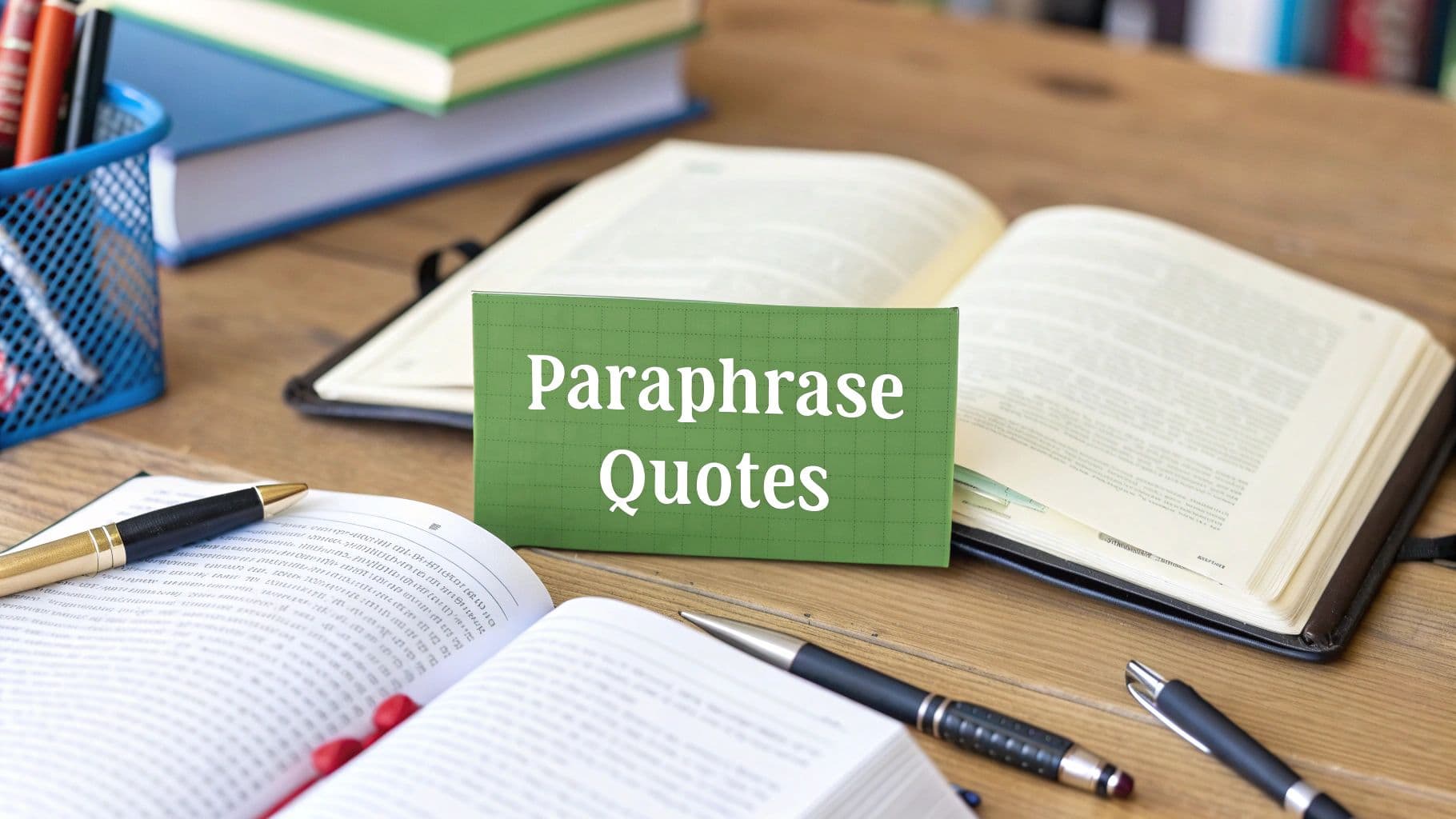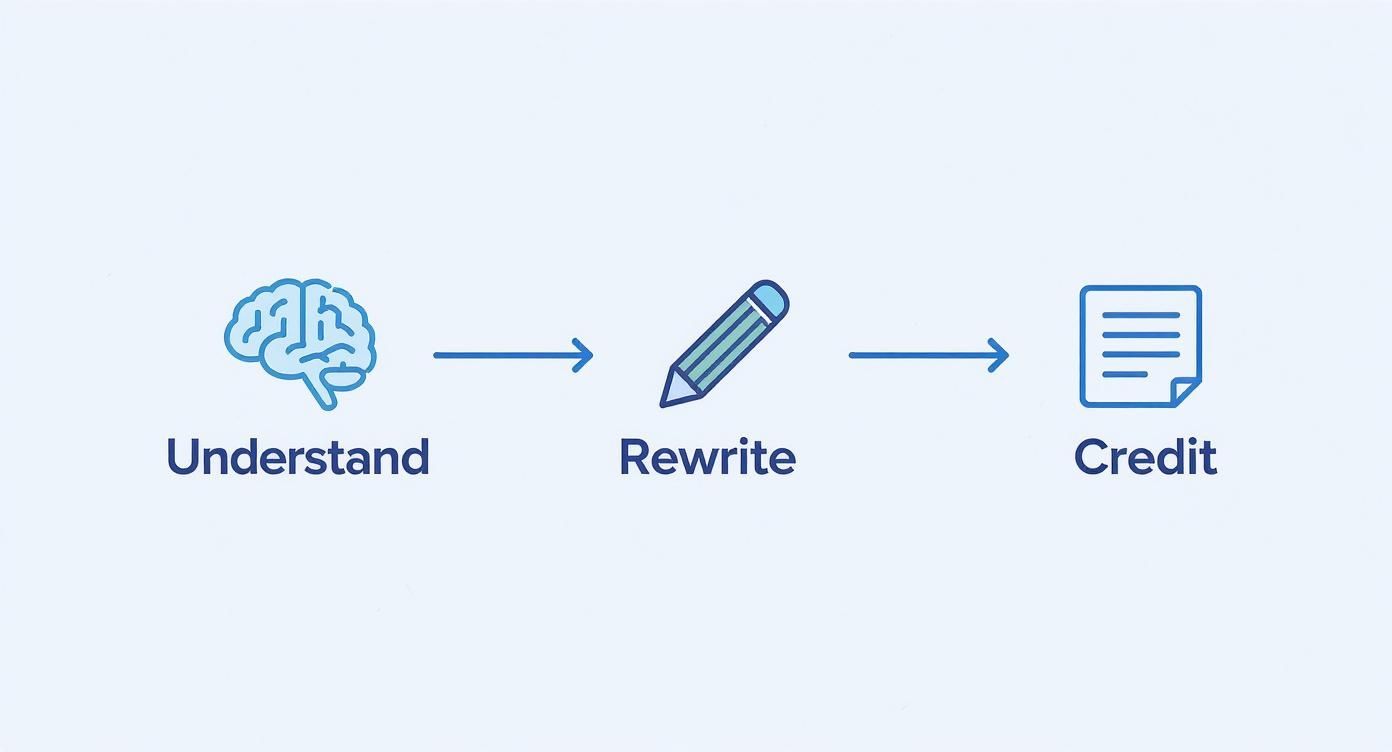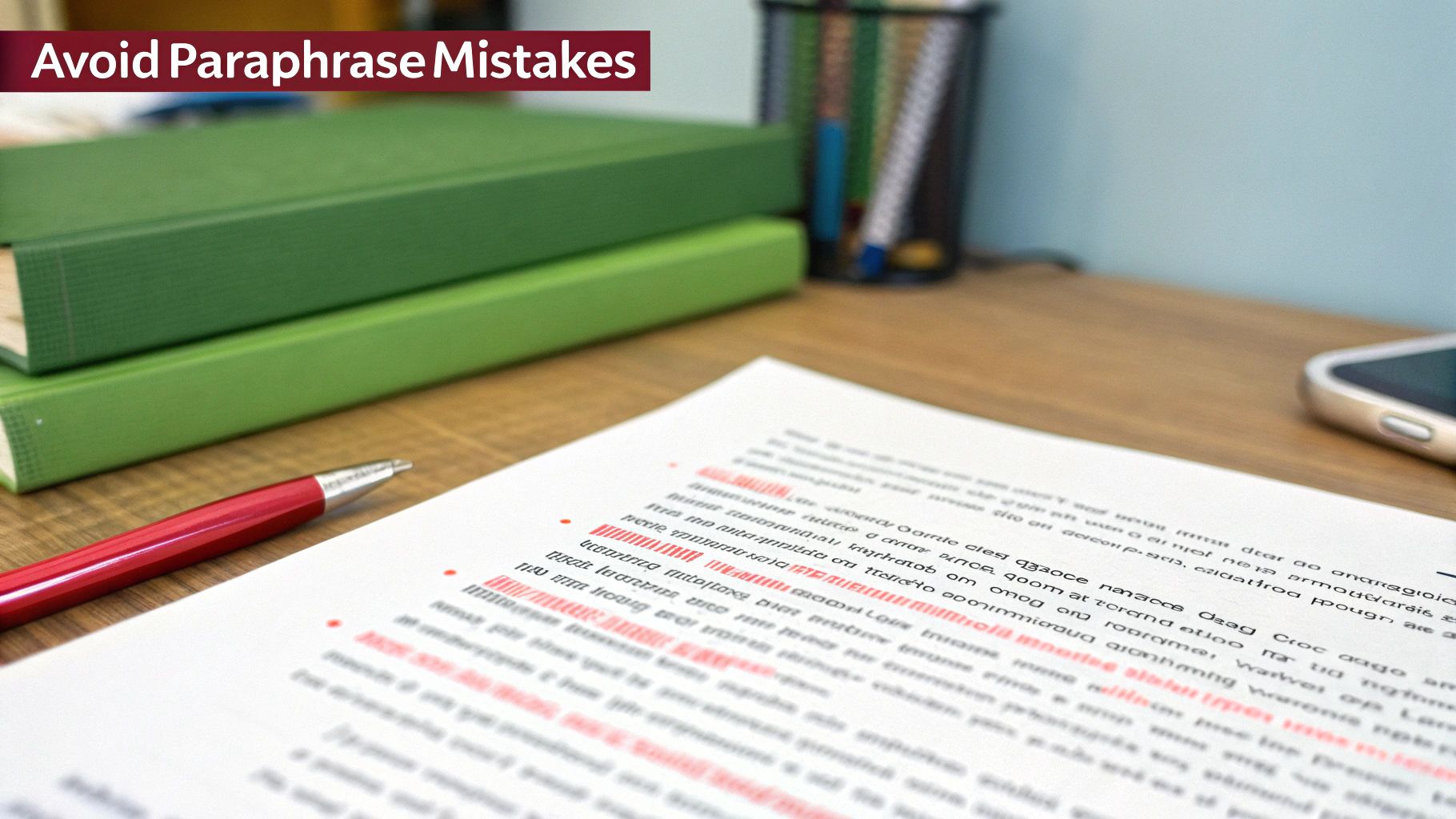
How to Paraphrase a Quote and Keep Its Meaning
November 14, 2025
Knowing how to paraphrase a quote isn't just about swapping out a few words—it's about truly understanding an idea and then explaining it in your own voice. You have to capture the original meaning, rebuild it with your own sentence structure, and always give credit to the source.
When you get this right, you're not just avoiding plagiarism; you're showing that you've actually engaged with the material.
Why Getting Good at Paraphrasing Is a Game-Changer
Mastering paraphrasing is more than just an academic exercise. It's a fundamental skill for anyone who wants to communicate clearly and think originally. Whether you're writing content for a blog or putting together a research paper, the ability to weave in external ideas without just copy-pasting sets your work apart.
It proves you didn't just read the source—you processed it.
There are a few big reasons this skill is so crucial:
- It Makes Your Arguments Stronger: When you paraphrase, you can smoothly blend evidence into your own narrative. This makes your points feel more authoritative and a lot more convincing.
- It Helps You Find Your Voice: Constantly dropping in direct quotes can make your writing feel choppy and inconsistent. Rephrasing ideas in your own words keeps the tone and style consistent from start to finish.
- It Keeps You Honest (and Out of Trouble): Proper paraphrasing, paired with a citation, is the cornerstone of ethical writing. It’s how you give credit where it's due and steer clear of accidental theft. We dive deeper into this in our guide on how to avoid plagiarism.
The Core Principles of Effective Paraphrasing
To get it right, it helps to think in terms of do's and don'ts. Here’s a quick breakdown of the foundational rules I always follow.
| Action (Do This) | Mistake (Avoid This) |
|---|---|
| Understand the original idea first. | Jumping straight to word replacement. |
| Completely change the sentence structure. | Keeping the same sentence flow. |
| Use your own vocabulary and phrasing. | Simply swapping words with synonyms (thesaurus abuse). |
| Always cite the original source. | Forgetting to give credit. |
| Preserve the original author's intent. | Accidentally twisting or misrepresenting the meaning. |
Stick to the "Do This" column, and you’ll be in a great position to paraphrase effectively and ethically every single time.
Why It Matters More Than Ever
The need for this skill has exploded recently. The global market for paraphrasing tools was valued at $1.15 billion and is on track to hit $3.87 billion by 2035. That's a massive jump.
This trend shows how much we're leaning on technology for writing help, but it also shines a light on a critical gap. Tools can swap words, but they can't always grasp context. That's why learning to do it well yourself is still an irreplaceable skill.
The real challenge isn’t just changing the words—it’s protecting the author’s original intent. A clumsy paraphrase can distort the source’s meaning just as badly as outright plagiarism, and it can tank your credibility just as fast.
At the end of the day, good paraphrasing is an act of translation. You're taking someone else's idea and translating it into your own context, for your own audience. This doesn’t just make your writing more dynamic; it actually deepens your own understanding of the topic. You stop being a passive reporter of facts and become an active participant in the conversation.
A Practical Method for Perfect Paraphrasing
Knowing how to paraphrase a quote is less about following rigid rules and more about adopting a repeatable workflow. Let’s move past the theory with a practical method that makes the process feel natural, not forced.
The goal is to internalize the original idea so completely that you can explain it in your own words without a second thought.
Your first move is always to deconstruct the original quote. Read it several times until you really get its core message, not just the words on the page. Ask yourself: what’s the author’s main point here? What emotion or conclusion are they trying to get across?
This simple flowchart lays out the core process, helping you remember the key stages: understand, rewrite, and credit.

This visual reinforces that good paraphrasing is a three-part harmony. Miss any one of these steps, and the entire effort falls flat. It all starts with genuine comprehension.
The Rewrite Without Looking Technique
Once you're confident you understand the quote’s essence, put the source material away. Seriously—close the tab or turn the page over. Now, try to rewrite the idea from memory using your own voice and sentence structure.
This little trick forces you to actually process the information rather than just shuffling the author’s words around. Because you aren’t looking at the original, you're far less likely to accidentally mimic its structure, which is one of the most common paraphrasing mistakes.
Pro Tip: Try explaining the concept out loud. If you can verbalize the idea clearly to a friend (or even just to yourself), you’re ready to write it down. This verbal processing helps solidify the concept in your own terms.
After you have your version down, it’s time to refine it.
- Compare and Contrast: Place your paraphrase next to the original quote. Does it capture the same meaning without using the same key phrases or sentence patterns?
- Check for Accuracy: Make sure you haven’t unintentionally twisted the author’s original intent. It's surprisingly easy to shift the meaning when rephrasing, so a careful check is vital.
- Credit Your Source: The final, non-negotiable step is to add a proper citation. The idea still belongs to the original author, and giving them credit is essential for maintaining your integrity.
By following this workflow—understand deeply, rewrite independently, and cite properly—you'll produce paraphrases that are both unique and honest. For a deeper look at different approaches, you can explore these advanced paraphrasing techniques to expand your toolkit.
How to Handle Complex and Technical Quotes
Paraphrasing a simple sentence is one thing. But what about when you’re staring down a dense academic quote or a line packed with technical jargon? That requires a different game plan.
Your goal isn't just to make it shorter; it's to translate the core meaning into language your audience can actually understand, all without butchering the important details.
Think of it like taking apart a machine to see how it works before you try to explain it to someone else. You need to isolate the main point, the supporting data, and any must-know terms.

Once you've deconstructed the quote, you can put it all back together in a way that makes sense.
Tackling Technical Language and Jargon
When you run into technical terms, your job is to be a translator. You’re converting specialized language into plain English that a non-expert can follow.
- Define in Context: If a technical term is absolutely essential, just define it right there in the sentence. For instance, "The study focused on mitigating anthropogenic climate forcings" becomes, "The study focused on reducing human-caused factors that drive climate change." Much better.
- Use Analogies: This is my favorite trick. Compare a complex idea to something familiar. Describing DNA replication as being “like a zipper unzipping and making a copy of each side” makes an invisible process instantly click for the reader.
This isn't about dumbing things down. It's about showing you've truly grasped the material well enough to explain it clearly.
The ultimate test of a good technical paraphrase is clarity. If a reader has to stop and look up a word you used, you haven't simplified enough. The goal is to build bridges, not more walls of jargon.
How to Paraphrase Statistics and Data
Numbers can be a real stumbling block. It's so easy to just copy the phrasing to avoid getting the data wrong, but that’s not really paraphrasing.
A study from the Walden University Writing Center actually found that 67% of students struggled to paraphrase numerical data without just copying it. But here’s the interesting part: after getting specific instructions, their accuracy jumped by 42%. This shows that having a clear strategy for stats is key.
To do it right, focus on what the numbers actually mean.
- Set the stage: Give the reader some context before you drop the number.
- Present the figure: State the key statistic using your own words and sentence structure.
- Explain why it matters: This is the most important step. Tell the reader the significance of the number.
Following this process turns a dry statistic into a powerful piece of evidence that makes your point for you. It's a non-negotiable skill if you want to paraphrase with integrity.
Common Paraphrasing Mistakes You'll Want to Avoid
Paraphrasing is a skill, and like any skill, it comes with a few common tripwires. Even seasoned writers can fall into these traps if they aren't careful. Spotting these mistakes in your own work is the first step, because they don't just feel sloppy—they can seriously damage your credibility.
The Thesaurus Trap
Probably the biggest and most common mistake is what I call the "thesaurus trap." This is when you take the original sentence and just swap a few words for synonyms. It’s a purely cosmetic change that doesn’t show you actually understand the source material. Worse, it usually ends up sounding clunky and unnatural.

This kind of word-swapping is a classic example of "patchwriting"—stitching bits of the original text into your own writing. The final result is way too close to the source, and that's when you start inching dangerously close to plagiarism.
Twisting the Author’s Original Meaning
Here's another big one: accidentally changing what the author actually meant. It’s surprisingly easy to do. When you get too focused on just changing the words, you can lose the original nuance or tone. You might end up making a weak claim sound absolute or a cautious suggestion sound like a proven fact.
Let's look at a real-world example:
- Original Quote: "The data suggests a possible correlation between screen time and sleep disruption."
- Incorrect Paraphrase: "The research proves that screen time causes poor sleep."
See the difference? The second version makes a hard-and-fast claim that the original author never made. That's a serious misrepresentation. Always, always double-check that your paraphrase keeps the original tone and level of certainty intact.
The goal isn't just to dodge plagiarism; it's to faithfully represent the original idea. A great paraphrase honors the source's meaning while fitting perfectly into the flow and voice of your own writing.
Forgetting to Give Credit
This one might seem obvious, but it happens all the time. Every single idea you paraphrase needs a citation—no exceptions. After you've done the hard work of rephrasing, failing to credit the original author undermines everything. Knowing how to properly cite your sources isn't just about academic rules; it's about building trust with your reader and strengthening your own arguments.
Paraphrasing Error Checklist
It can be tough to spot these issues in your own writing. I've put together this quick checklist to help you diagnose and fix the most common paraphrasing mistakes before they become a problem.
| Common Mistake | How to Identify It | How to Fix It |
|---|---|---|
| The "Thesaurus Trap" | Your sentence has the exact same structure as the original, just with different words. | Read the original idea, then step away and write it in your own words from memory. Focus on the concept, not the sentence. |
| Twisting the Meaning | Your paraphrase makes a stronger or weaker claim than the original quote. | Compare your version side-by-side with the original. Pay close attention to qualifying words like "suggests," "proves," "might," or "always." |
| Missing the Nuance | You captured the main point but lost the author's tone (e.g., sarcasm, caution, excitement). | Read the original text in context. Is the author being serious? Skeptical? Adjust your word choice to reflect that tone. |
| Forgetting the Citation | You've rephrased an idea from another source but haven't included a citation immediately after. | Make it a habit: as soon as you paraphrase, add the citation. Don't wait until the end. |
Running your paraphrased sections through this quick check can save you a lot of headaches later on and ensure your work is both original and honest.
Tools and Techniques for Better Paraphrasing
Knowing the steps is one thing, but mastering paraphrasing means having the right techniques and tools in your back pocket. Simply swapping out a few words isn't enough. You have to get to the core of an idea and rebuild it in a way that feels completely natural.
A surprisingly powerful trick is concept mapping. Before you even start writing, grab a piece of paper and sketch out the quote's main idea in a central bubble. Then, draw branches for all the supporting points and nuances. This simple visual exercise breaks the quote down into its essential parts, making it much easier to explain from a fresh angle.
Another great method is what I call the "teach it to a friend" technique. Just imagine you have to explain the quote's meaning to someone who has no idea what you're talking about. This forces you to ditch the complex jargon and find your own words to get the point across—which is exactly what good paraphrasing is all about.
Using AI Paraphrasing Tools Strategically
AI can give you a solid starting point, but it's never the final answer. An AI paragraph rewriter can be a fantastic way to discover new sentence structures or vocabulary you hadn't considered. If you're looking for more options, there are plenty of AI content creation tools out there that can help brainstorm different phrasing.
But here’s the catch: relying on them completely is a huge mistake. AI often strips out the author's original tone, leaving you with text that sounds generic and robotic. The smartest way to use an AI paraphraser is to treat its output as a rough first draft—something you can react to and build from.
Think of AI paraphrasers as a brainstorming partner, not a ghostwriter. Your job is to take their suggestions, inject your own voice, and ensure the final output is accurate, human, and aligns with your overall message.
Ultimately, the goal is to humanize the AI's output. Take the clunky, machine-generated phrasing and polish it until it flows. By combining smart manual techniques with the strategic use of tools, you can elevate your paraphrasing from a simple chore to a truly sophisticated writing skill.
The Paraphrasing Questions We Hear All the Time
Even after you get the hang of paraphrasing, a few specific questions always seem to come up. Getting those nagging doubts cleared up can make all the difference, helping you write with more confidence and make sure your work is both ethical and effective.
Let's dive into the most common questions writers have about this essential skill.
Is Paraphrasing the Same as Summarizing?
Not quite. The biggest difference is scope.
When you paraphrase, you’re recasting a single, specific idea from a source in your own words. The length usually stays about the same. You're drilling down on one particular point and explaining it your way, without losing its original nuance.
Summarizing, on the other hand, is about condensing the big picture. You're taking a much larger piece of text—like a whole article or a book chapter—and shrinking it down to its main arguments. A summary is always way shorter than the original.
Do I Really Need a Citation if I Paraphrased It?
Yes. Always. This is the one rule you can't bend.
Just because you changed the words doesn't mean the idea is yours. The original research, insight, or concept still belongs to the author who did the work.
Skipping the citation is plagiarism, plain and simple. You're essentially passing off someone else's thinking as your own. Citing your sources is about more than just avoiding trouble; it shows you’ve done your homework and adds serious credibility to your own arguments.
Paraphrasing without citation is like singing a song with new lyrics but claiming you wrote the melody. The core creative work isn't yours, and giving credit is the only ethical way to use it.
Can I Just Use an AI Paraphrasing Tool?
AI tools can be a decent starting point, but they should never be the final author. Think of them as a brainstorming partner to help you find a different angle or get past a block. But you absolutely have to use them with caution.
AI often misses the subtle meaning behind the words, butchers the original tone, and spits out sentences that sound clunky and robotic. The best way to use these tools is to take their suggestions as a rough draft. From there, it's your job to review, edit, and rewrite the output until it’s accurate, sounds human, and actually fits your voice.
How Much of the Original Do I Have to Change?
Forget about trying to hit a magic number, like changing 51% of the words. That’s not how it works.
Real paraphrasing isn't about swapping a few words with a thesaurus—that's a bad habit called "patchwriting," which is still considered plagiarism. True paraphrasing is about absorbing the idea and then explaining it from a completely different structural and conceptual angle.
The real test? You’ve demonstrated that you truly understand the concept by rebuilding it from the ground up, in your own style.
Ready to turn robotic AI drafts into polished, natural writing? Natural Write instantly humanizes your text, ensuring it flows perfectly and bypasses AI detection. Try it for free and see the difference at https://naturalwrite.com.


